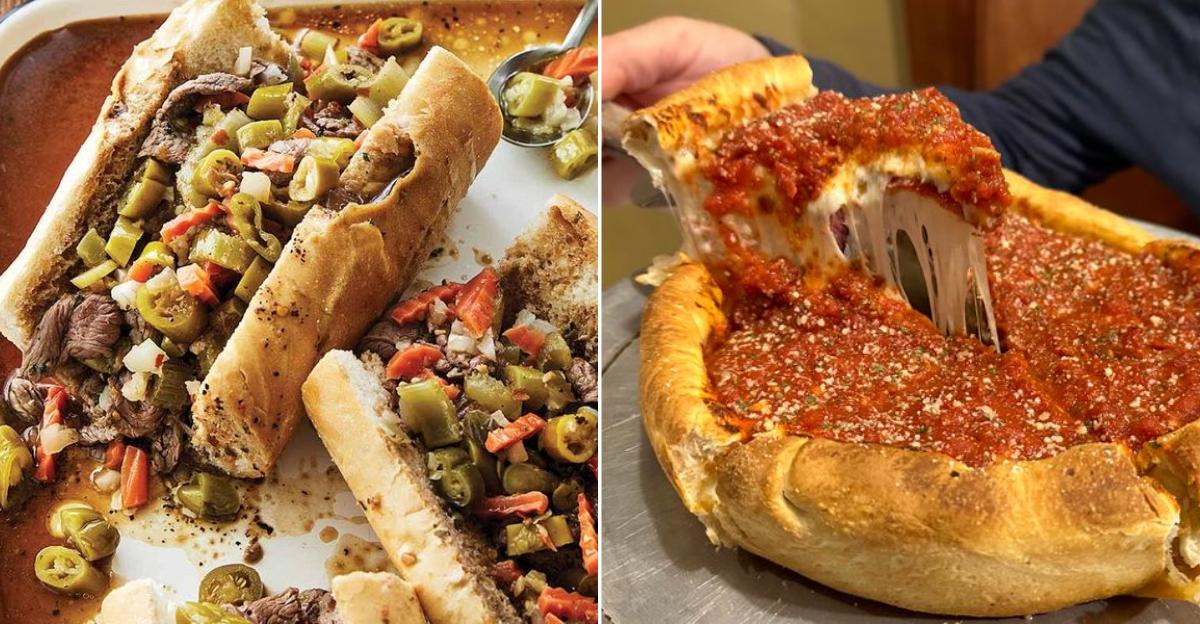14 Illinois Recipes That Locals Insist Are Untouchable (Especially If You’re Not From There)

Growing up in the Land of Lincoln taught me one thing for sure: we take our food seriously.
Illinois cuisine isn’t just sustenance—it’s our heritage served on a plate.
From Chicago’s iconic street foods to downstate comfort classics, these recipes have survived generations, perfected in family kitchens and neighborhood joints alike.
Mess with these dishes at your own risk—Illinois folks guard these recipes like family treasures.
1. Chicago-Style Hot Dog: The Sacred Seven-Topping Wonder
Last summer, I witnessed a tourist ask for ketchup on his Chicago dog. The vendor’s face crumpled like he’d been personally betrayed. That’s because a proper Chicago dog isn’t just a meal—it’s a religion.
The formula is non-negotiable: an all-beef frankfurter nestled in a steamed poppy seed bun, topped with yellow mustard, neon-green relish, chopped onions, tomato wedges, a pickle spear, sport peppers, and a dash of celery salt. Nothing more, nothing less.
What makes this combination magical is the perfect balance tangy, sweet, spicy, and savory all in one bite. Developed during the Depression era when vendors needed to turn a simple hot dog into a filling meal, it’s now our culinary calling card.
2. Tavern-Style Pizza: The Real Chicago Pizza Secret
While tourists line up for deep-dish, my Friday nights growing up always featured tavern-style pizza—the pie Chicagoans actually order most. This unsung hero is cracker-thin, cut into small squares (not triangles!), and served on paper plates in neighborhood bars across the city.
The beauty lies in its simplicity: a yeast-free crust rolled whisper-thin, topped edge-to-edge with tangy sauce and a generous blanket of mozzarella. The signature square-cut creates the coveted “corner pieces” with extra-crispy edges that family members silently battle over.
Developed in working-class taverns as complimentary bar snacks (the salt making patrons thirstier), this style remains Chicago’s best-kept pizza secret. Locals don’t correct tourists who think deep-dish is our only pizza, we’re happy keeping this treasure to ourselves.
3. Horseshoe Sandwich: Springfield’s Open-Faced Indulgence
First time my cousin from Springfield served me a Horseshoe, I thought he was pulling my leg. “That’s not a sandwich that’s a heart attack on a plate!” I laughed. Invented at the Leland Hotel in Springfield in the 1920s, this downstate delicacy defies all sandwich logic.
It starts innocently enough with thick-sliced toast, topped with your choice of meat (hamburger patties are traditional, but ham or turkey work too). Then comes the madness: the entire construction gets absolutely smothered in crispy French fries and drenched in a creamy, beer-infused Welsh rarebit cheese sauce.
Named for its original horseshoe-shaped ham portion, smaller versions are adorably called “Ponyshoes.” It’s the ultimate hangover cure and Springfield’s contribution to Illinois’ comfort food legacy.
4. Deep-Dish Pizza: The Casserole-Like Controversy
My Italian grandmother would smack me for saying this, but deep-dish pizza is more like a casserole than traditional pizza and that’s what makes it magnificent. Invented at Pizzeria Uno in 1943, this Chicago icon features a buttery, cornmeal-dusted crust that climbs up the sides of a deep pan like a fortress wall.
Unlike its New York cousin, we stack our ingredients in reverse: cheese on the bottom (to prevent burning during the long bake), followed by meat and veggies, all crowned with a lake of chunky tomato sauce. The result? A knife-and-fork affair that requires patience, these babies take 45 minutes to bake properly.
Out-of-towners might mock our pizza’s depth, but one bite of that molten interior usually converts even the most dedicated thin-crust devotees.
5. Italian Beef Sandwich: The Juicy Masterpiece
The sound still haunts me that squelchy, wonderful noise when the guy at Johnnie’s dipped my Italian beef in jus and the roll soaked up the beefy goodness. No sandwich captures Chicago’s working-class roots better than this messy marvel.
Thinly sliced roast beef, slow-cooked with garlic and Italian herbs, gets piled onto a sturdy Italian roll that’s been briefly dunked in seasoned beef juices. The standard order includes sweet bell peppers or spicy giardiniera (or both if you’re doing it right).
The sandwich comes “dry” (barely dipped), “wet” (quickly dunked), or “dipped” (completely soaked). True aficionados eat it with elbows extended forward—the “Italian stance”—to avoid wearing the inevitable drippings home. Worth every napkin!
6. Maxwell Street Polish: The Street Food Champion
My first Maxwell Street Polish came after a Cubs game when I was ten, the smell of onions caramelizing on a flat-top grill still triggers that memory. This street food masterpiece began in Chicago’s Maxwell Street Market, once the bustling heart of immigrant commerce.
Unlike a regular Polish sausage, the Maxwell Street version features a garlicky, smoked pork sausage that’s butterflied and chargrilled until slightly crispy. It’s nestled in a plain white bun and crowned with yellow mustard, a mountain of grilled onions, and optional sport peppers for heat.
When Jim’s Original and Express Grill were forced to relocate from their historic Maxwell Street locations, Chicagoans proved that it’s the recipe, not the address, that matters. One bite delivers the perfect harmony of snap, smoke, sweetness, and spice.
7. Shrimp DeJonghe: Chicago’s Oldest Culinary Treasure
Grandma only made Shrimp DeJonghe twice a year—Christmas and my grandfather’s birthday which is how I knew it was something special. This elegant casserole is Chicago’s oldest native dish, created in the early 1900s at DeJonghe’s Hotel and Restaurant.
Plump shrimp are bathed in a decadent mixture of garlic-infused butter, sherry, and white wine, then topped with seasoned breadcrumbs before being baked until golden. The secret lies in the breadcrumb mixture—each family guards their blend of herbs like a state secret, though most include paprika, nutmeg, and cayenne.
While other cities claim fancier seafood dishes, this Belgian-influenced creation remains uniquely Chicagoan. It bridges the gap between simple comfort food and special-occasion dining, proving our culinary heritage extends well beyond hot dogs and pizza.
8. Chicken Vesuvio: The One-Pan Italian-American Marvel
Sunday dinner at my Uncle Vito’s always featured Chicken Vesuvio, his signature dish that made everyone fight over who got to sop up the last bit of sauce with crusty bread. Despite its Italian name, you won’t find this dish in Italy’s pure Chicago, born in our Italian-American neighborhoods.
Bone-in chicken pieces are seared until golden, then roasted with potato wedges, whole garlic cloves, and green peas in a white wine and herb sauce. The magic happens when the chicken juices mingle with the wine and olive oil, creating a sauce that’s somehow both light and indulgent.
Legend claims it was created at the now-defunct Vesuvio Restaurant on Wacker Drive in the 1930s. Whatever its origins, this dish represents Chicago’s knack for transforming immigrant recipes into something uniquely ours.
9. Pork Chop Sandwich: The Blue-Collar Delicacy
My first encounter with a proper Illinois pork chop sandwich came from a roadside stand outside Peoria—a simple paper bag already translucent with grease. Unlike fancy restaurant versions, our pork chop sandwich stays true to its working-class roots.
A bone-in pork chop (yes, with the bone still in!) gets pounded thin, breaded, and fried until golden brown. It’s served on a soft white bun with mustard and raw onions, nothing fancy, nothing fussy. The bone juts out from the sandwich like a handle, creating a unique eating experience that confounds visitors but delights locals.
Originally popular in coal mining communities and steel towns across Illinois, this practical lunch allowed workers to hold the sandwich by the bone, keeping their dirty hands off the edible portion. Simple necessity created culinary tradition.
10. Chicago-Style Smoked Rib Tips: South Side Barbecue Brilliance
The first time I tasted proper Chicago rib tips, I was standing in line at Lem’s Bar-B-Q on the South Side, sauce dripping down my fingers while strangers nodded in understanding. These aren’t the neat baby back ribs you’ll find in chain restaurants, they’re messy, magnificent morsels of pure flavor.
Rib tips are the cartilage-heavy ends cut from spare ribs, smoked low and slow over oak wood, then chopped into bite-sized chunks. The result is crispy, chewy, tender pieces drenched in tangy-sweet tomato-based sauce and served atop white bread with hot sauce and pickles.
Chicago’s distinctive style evolved from Great Migration traditions, with Mississippi and Alabama pitmasters adapting their techniques to urban settings. The aquarium smoker, a glass-fronted cabinet smoker—became our signature equipment, visible in legendary spots from Lem’s to Honey 1 BBQ.
11. Baked Sausage And Peppers: The Church Picnic Essential
Every summer, my grandmother would volunteer at St. Theresa’s church picnic, spending hours tending to massive foil pans of sausage and peppers. The smell would waft across the entire neighborhood, drawing crowds before the food was even ready.
This Italian-American staple features plump Italian sausages (both hot and sweet) nestled among a rainbow of bell peppers, onions, and garlic, all roasted until caramelized and swimming in their own juices and olive oil. Some families add potatoes, others tomatoes, but the essence remains the same: simple ingredients transformed through slow cooking.
While not exclusive to Illinois, our version has become a fixture at every neighborhood festival, church function, and family gathering across the state. The beauty lies in its adaptability; serve it on crusty bread as a sandwich or over polenta or pasta for a heartier meal.
12. Giardiniera: The Condiment That Rules Them All
My refrigerator has never been without a jar of giardiniera, it’s practically a requirement for Illinois residency. This spicy, oil-packed vegetable medley might have Italian roots (the name means “from the garden”), but Chicago has elevated it from condiment to cultural icon.
Our version features a mix of serrano peppers, celery, carrots, cauliflower, and olives, marinated in seasoned vegetable oil rather than the vinegar brine used in traditional Italian versions. The result is a complex flavor bomb that adds heat, acidity, and crunch to anything it touches.
The divide between “hot” and “mild” giardiniera preferences has started more family arguments than politics at my dinner table. While it’s famous as the essential topping for Italian beef sandwiches, true Illinoisans put this stuff on everything—eggs, pizza, sandwiches, and even straight from the jar at midnight.
13. Garrett’s Chicago-Mix Popcorn: The Sweet-Savory Addiction
The smell hits you a block away—that intoxicating blend of caramel and cheese that means only one thing: Garrett’s. I’ve personally witnessed dignified business executives sprinting to catch the last batch before closing time.
The genius of Chicago-Mix (now officially called “Garrett Mix” after trademark issues) is the seemingly odd combination of orange cheddar cheese popcorn with caramel-coated kernels in the same bag. The contrasting flavors—salty, sweet, tangy, buttery create an addictive experience that’s greater than the sum of its parts.
Garrett Popcorn Shops opened in 1949, but the mix became legendary in the 1980s when customers started requesting both flavors together. Now it’s the snack visitors ship home and locals bring to parties, though the struggle not to devour the entire bag on the train ride home is very real.
14. Eli’s Cheesecake: The Lighter-Than-Air Dessert Legend
My wedding cake wasn’t cake at all, it was tiers of Eli’s Cheesecake, because in Chicago, that’s how you show guests you care. Unlike dense New York-style versions, Eli’s signature cheesecake floats somewhere between cheesecake and mousse, with a shortbread cookie crust that adds the perfect textural contrast.
Created by Eli Schulman for his legendary Eli’s The Place for Steak restaurant in 1980, the cheesecake became so popular it eventually spawned its own company. The secret to its distinctive texture? Hot cream cheese is whipped with sugar, eggs, and vanilla, then baked in small batches at high heat.
Eli’s gained national attention when they created a 2,000-pound cheesecake for Chicago’s 150th birthday celebration. Today, their cheesecakes ship nationwide, but nothing beats getting one fresh from their Chicago bakery cafe.
